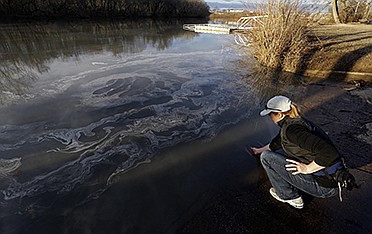RALEIGH, N.C. (AP) - Federal officials said Tuesday that toxic coal ash has coated the bottom of a North Carolina river as many as 70 miles downstream of a Duke Energy dump where a massive spill occurred two weeks ago.
The U.S. Fish and Wildlife Service advised that a massive pile of coal ash about 75 feet long and as much as 5 feet deep has been detected on the bottom of the Dan River near the site of the Feb. 2 spill. Deposits varying from 5 inches deep to less than 1 inch coated the river bottom across the state line into Virginia and to Kerr Lake, a major reservoir.
Federal authorities expressed concern for what long-term effect the contaminants will have on fish, mussels and other aquatic life. Public health officials have advised people to avoid contact with the water and not eat the fish.
"The deposits vary with the river characteristics, but the short- and long-term physical and chemical impacts from the ash will need to be investigated more thoroughly, especially with regard to mussels and fish associated with the stream bottom and wildlife that feed on benthic invertebrates," said Tom Augspurger, a contaminants specialist at the federal wildlife agency. Benthic invertebrates are small animals that live in the sediments of rivers and lakes, such as clams, worms and crustaceans.
The Dan River system in North Carolina and Virginia is home to two federally listed endangered species, the Roanoke logperch fish and the James spinymussel. The river also has another freshwater mussel, the green floater, which is currently being evaluated for protection under the U.S. Endangered Species Act.
Officials said the coal ash is burying aquatic animals and their food. The ash, generated when coal is burned to generate electricity, could also clog gill tissues in fish and mussels. The agency said public reports of dead aquatic turtles at two state parks in Virginia had not yet been verified by federal biologists.
Authorities said public drinking water in Danville, Va., and other communities downstream of the spill site remain safe. Heavy metals detected in the river at levels exceeding state and federal safety standards - including arsenic, lead and selenium - are being successfully filtered out of water drawn from the river at municipal treatment plants, they said.
The U.S. Environmental Protection Agency has warned that increased flow in the river resulting from last week's snowfall and rain threatens to wash the toxic ash even further downstream.

